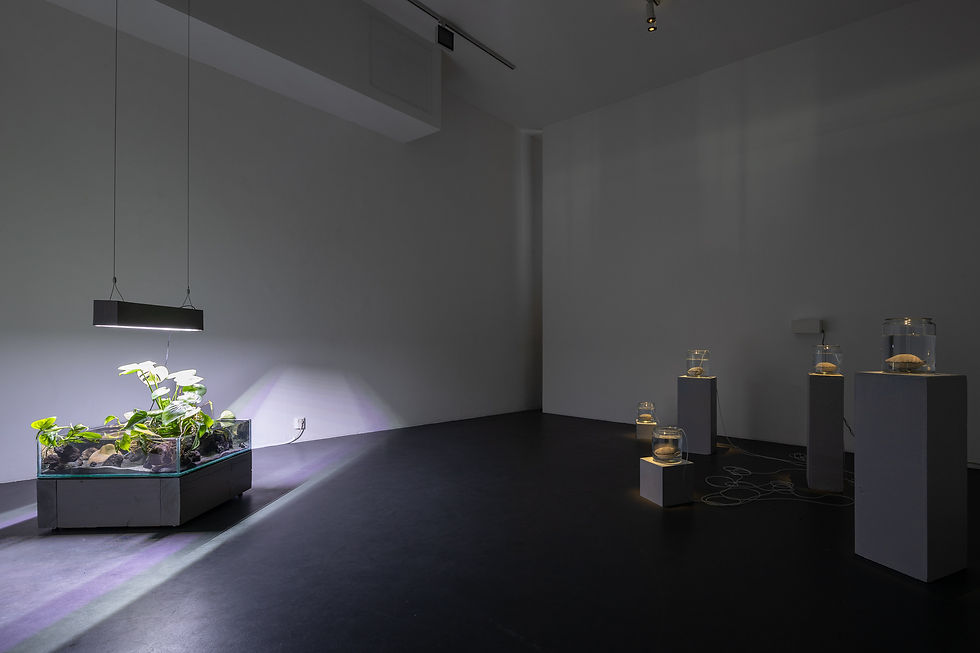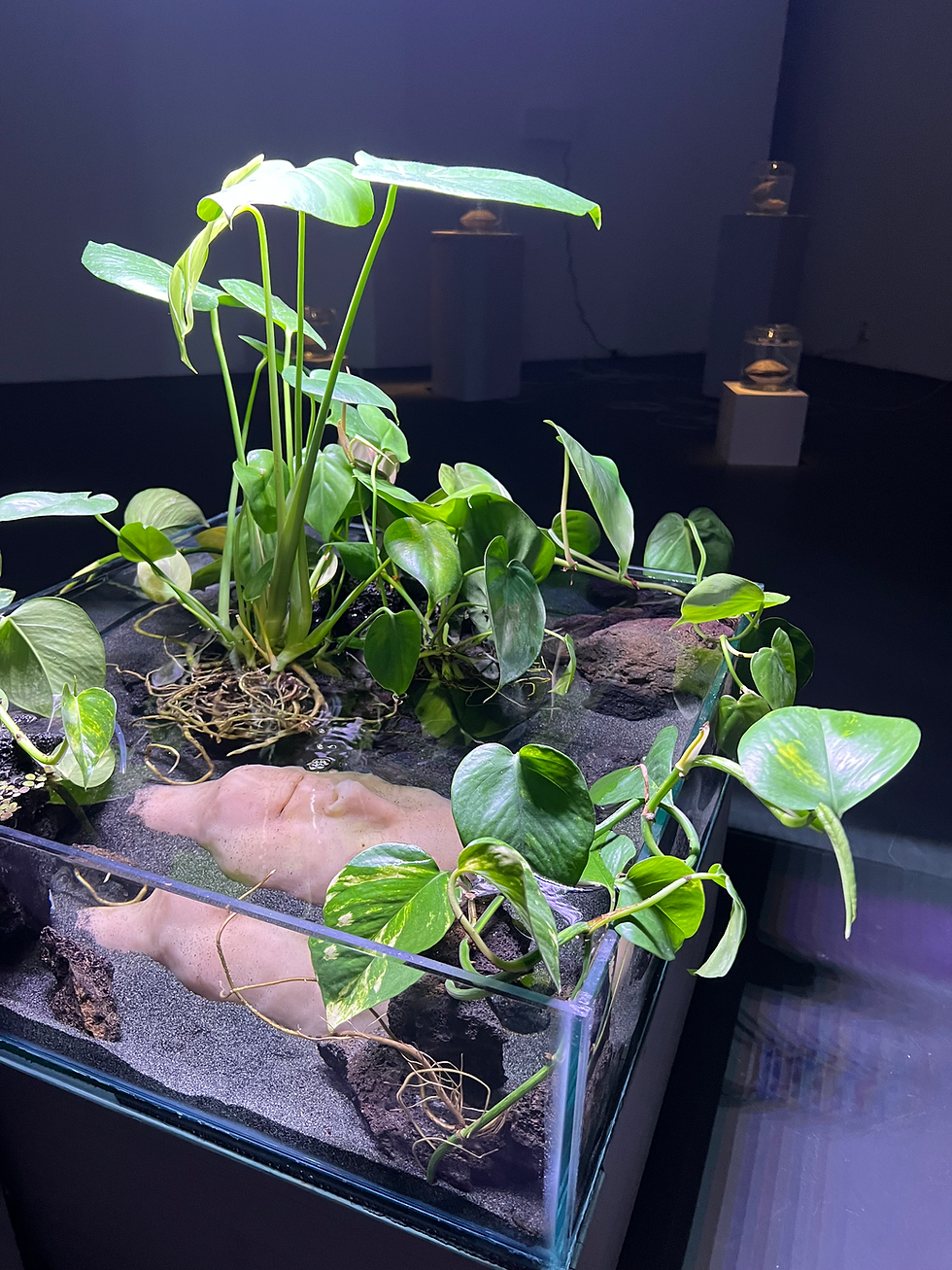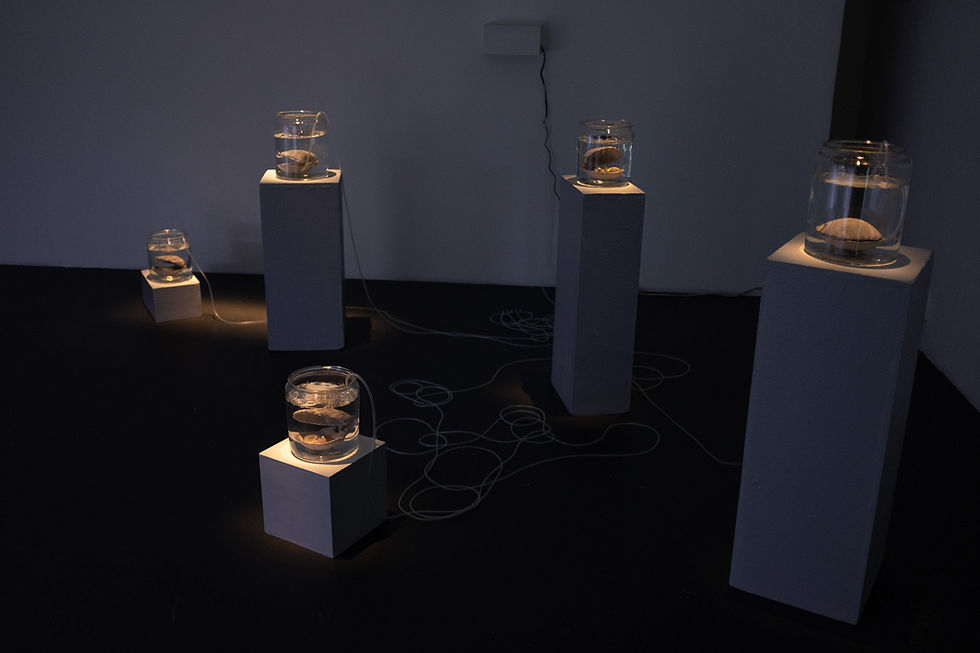Immersed, curious – Text by Suvi Vepsä (2025)
- Lilli Haapala

- Oct 2
- 4 min read
Updated: Oct 3

Garden of curiosities, Gallery Sculptor, Helsinki 5/ 2025
Immersed, curious 08/2025
In a dark room, a Monstera deliciosa and Epipremnum aureum growing towards the purple light hanging above them, their roots reaching in multiple directions for something to grab on to in a shallow water tank they were planted in. Among them, half-buried in black sand, an outline of a face, Homo sapiens, it seems. Lying there, eyes closed, with a restful look on their face. It looks like they have been there for a long time, marks of time on their silicone skin, faded and pale, wrinkly and somehow sunken. A steady machinic hum is broken by the rhythmic sound of bubbles bursting to the surface. On the other corner of the room, glass jars, each holding a clam made from clay. A machine connected to them pushes air in the water and forces the shells open, offering a peek at what they are hiding underneath their protective shells. Here, life is new, growing. Almost familiar, somehow recognisable, but then again not quite. What kind of garden is this? A utopic place where humans become something new, in harmony with nature? A memorial for something we once were? Or a post-apocalyptic laboratory for a future where our lives have become irretrievably dependent on technology?
Today, humanity stands at a critical threshold, facing the climate crisis and ecological collapse that force us to rethink our relationship with the natural world. On one side, there are techno-utopian dreams of redesigning ourselves and the planet through biotechnology and climate engineering: a belief that we can innovate our way out of trouble, even abandon Earth altogether. On the other side, an attempt to preserve and restore what is left, to take back the damage done, by returning to a long-lost harmony with nature, or removing us from it altogether. In this tension, a garden becomes a fitting metaphor. A garden can feel like a refuge, a place to reconnect with nature as the world around us collapses. Yet, at the same time, as art historian Giovanni Aloi notes, it is a carefully controlled environment, shaped and trimmed according to human ideals of beauty and order. (1 This paradox lies at the heart of our current moment: our attempts to restore nature often rely on the same logic of control that led to its degradation in the first place.
Calls for technoscientific fixes and nostalgic retreats are two sides of the same story – a story we keep telling ourselves, one whose ending is still in our hands. Whichever version we choose, the underlying assumption is the same: we are still in control, still separated from nature. But we are clinging to a false narrative. There is no nature “out there,” separate from us, as something we can escape or return to. Philosopher Emanuele Coccia, for example, argues that living in the world is not about being cast into an environment, nor being above it, but about total immersion, as intimate and innate as breathing.(2 “[I]t is impossible to liberate oneself from the environment in which one is immersed, and it is impossible to purify this environment of our presence”, Coccia writes.3 Living, then, should be about being in relation, not about being in control. The human in the water tank slowly sighs, air bubbles race towards the surface. We make the world as it makes us.
Cultural theorist Astrida Neimanis has approached these more-than-human entanglements through bodies of water, calling for a deeper understanding of the ways in which we are fundamentally shaped by and dependent on different aquatic life forces.4 As watery beings, we are immersed in the flows of water across temporal, spatial, and ecological cycles, most of which remain invisible or unknown to us.(5 In the exhibition, Haapala invites us to follow these currents, from our uncertain present to worlds yet to come. How powerful yet fragile these processes are. How inseparable their faith is from ours. How much of it out of our control.
If there is no way out of these deep waters, how do we prevent getting in over our heads?
According to Neimanis, thinking with bodies of water offers us imaginative tools for addressing the consequences of our past and current actions, without holding onto technoscientific dreams of escape or romantic fantasies of repair.(6 We cannot change what has been done. Nor can we know what the future holds. This does not mean we should abandon our visions for better futures or withdraw from action. We must stay curious. But this curiosity cannot be rooted in nostalgia or mastery.(7 To cultivate a flourishing garden, we need to let go of the illusion of control. Haapala’s underwater garden encourages us to imagine possible futures, not to proclaim what we should become, but to turn the focus on what we already are: always already more-than-human, and therefore, not the ones in charge.
1 See: Giovanni Aloi, “Falling from Grace,” in Why Look at Plants? The Botanical Emergence in Contemporary Art, ed. Giovanni Aloi (Brill, 2018), 105.
2 Emanuele Coccia, The Life of Plants: A Metaphysics of Mixture (Polity Press, 2019), 74. 3 Coccia, The Life of Plants, 74.
4 Astrida Neimanis, Bodies of Water: Posthuman Feminist Phenomenology (Bloomsbury Academic, 2017).
5 Neimanis, Bodies of Water, 94–95.
6 Neimanis, Bodies of Water,15.
Rather than control, curiosity should be rooted in care. See: Donna J. Haraway, When Species Meet (University of Minnesota Press, 2008), 36, 301.; Taru Elfving and mirko nikolić, “Experiments in Breathing, Contagious,” Antennae 48 (2018): 28, 31.





Comments